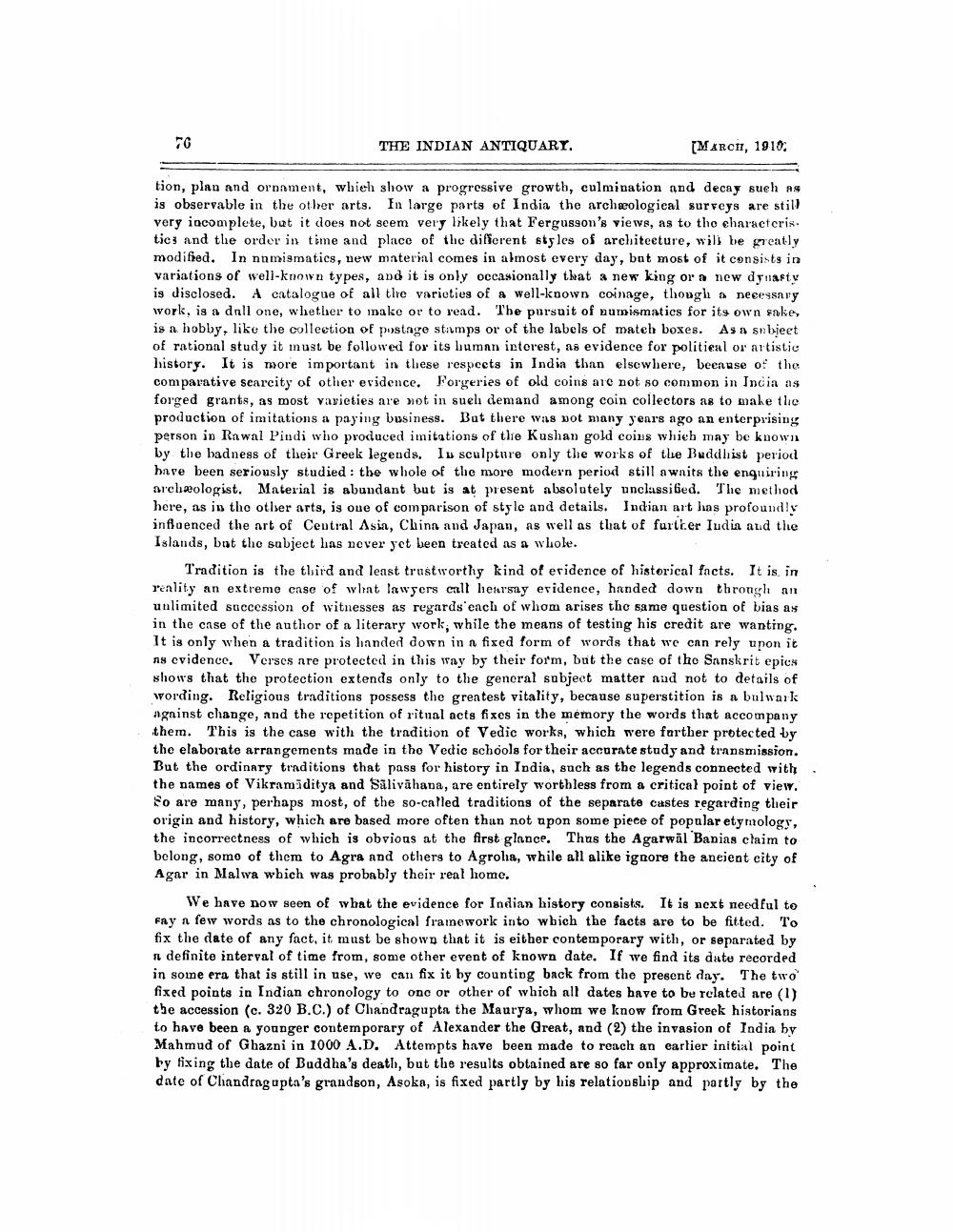________________
THE INDIAN ANTIQUARY.
[MARCII, 1910,
tion, plan and ornament, which show a progressive growth, culmination and decay sueh as is observable in the other arts. In large parts of India the archeological surveys are still very incomplete, but it does not seem very likely that Fergusson's views, as to the characteris. tics and the order in time and place of the different styles of architeeture, will be greatly modified. In nomismaties, new material comes in almost every day, but most of it consists in variations of well-known types, and it is only occasionally that a new king or a new dynasty is disclosed. A catalogue of all the varieties of a well-known coinage, though a necessary work, is a doll one, whether to make or to read. The pursuit of numismatics for its own sake, is a hobby, like the collection of postage stamps or of the labels of match boxes. As a snbjeet of rational study it inust be followed for its buman interest, as evidence for politieal or artistic history. It is more important in these respects in India than elsewhere, because of the comparative searcity of other evidence. Forgeries of old coins are not so common in India as forged grants, as most varieties are not in suel demand among coin collectors as to make the production of imitations a paying business. But there was not many yenrs ago an enterprising person in Rawal Pindi who produced imitations of the Kushan gold coins which may be known by the hadness of their Greek legends. In sculpture only the works of the Buddhist period bare been seriously studied : the whole of the more modern period still awaits the enquiring archæologist. Material is abundant but is at present absolutely unclassited. The method here, as in the other arts, is one of comparison of style and details. Indian art has profoundly infloenced the art of Central Asia, China and Japan, as well as that of further Iudia and the Islands, but the subject has never yet been treated as a whole.
Tradition is the third and least trustworthy kind of eridence of historical facts. It is in reality an extreme case of what lawyers call learsay evidence, handed down throngh an unlimited succession of witnesses as regards each of whom arises the same question of bias as in the case of the author of a literary work, while the means of testing his credit are wanting. It is only when a tradition is handed down in a fixed form of words that we can rely upon it As evidence. Verses are protected in this way by their form, but the case of the Sanskrit epics shows that the protection extends only to the general subject matter and not to details of wording. Religious traditions possess the greatest vitality, because superstition is a bulwark against change, and the repetition of ritual acts fixes in the memory the words that accompany them. This is the case with the tradition of Vedic works, which were further protected by the elaborate arrangements made in the Vedic schools for their accurate study and transmission. But the ordinary traditions that pass for history in India, such as the legends connected with the names of Vikramiditya and Salivāhana, are entirely worthless from a critical point of view. So are many, perhaps most, of the so-called traditions of the separate castes regarding their origin and history, which are based more often than not upon some piece of popular etymologs, the incorrectness of which is obvious at the first glance. Thus the Agarwal Banias claim to belong, somo of them to Agra and others to Agroha, while all alike ignore the ancient city of Agar in Malwa which was probably their real home.
We have now seen of what the evidence for Indian history consists. It is next needful to Fay n few words as to the chronological framework into wbich the facts are to be fitted. To fix the date of any fact, it must be shown that it is either contemporary with, or separated by i definite interval of time from, some other event of known date. If we find its date recorded in some era that is still in use, we can fix it by counting back from the present day. The two fixed points in Indian chronology to one or other of which all dates bave to be related are (1) the accession (c. 320 B.C.) of Chandragupta the Maurya, whom we know from Greek historians to have been a younger contemporary of Alexander the Great, and (2) the invasion of India by Mahmud of Ghazni in 1000 A.D. Attempts have been made to reach an earlier initial point by fixing the date of Buddha's death, but the results obtained are so far only approximate. The date of Chandragupta's grandson, Asoka, is fixed partly by his relationship and partly by the
.




